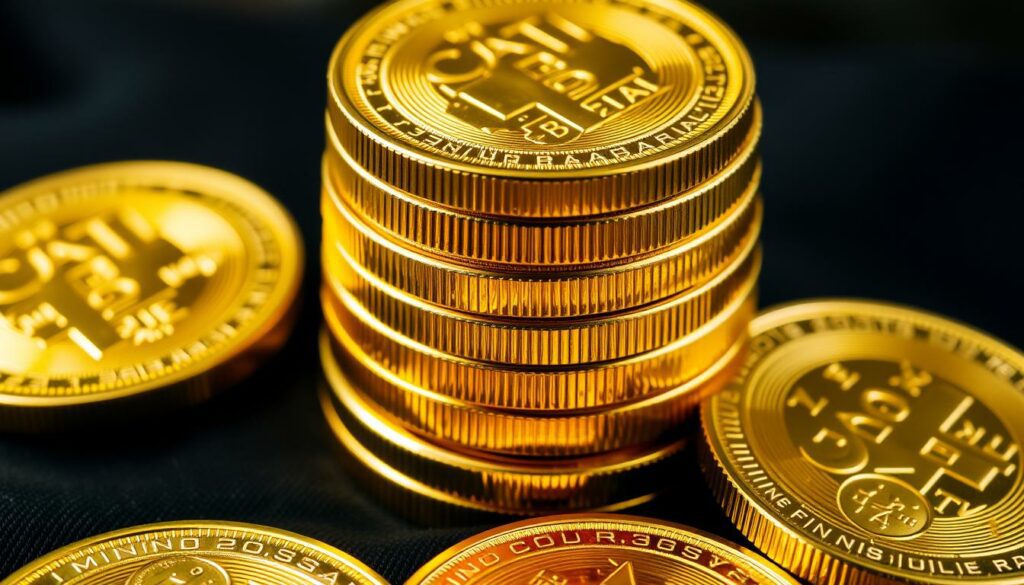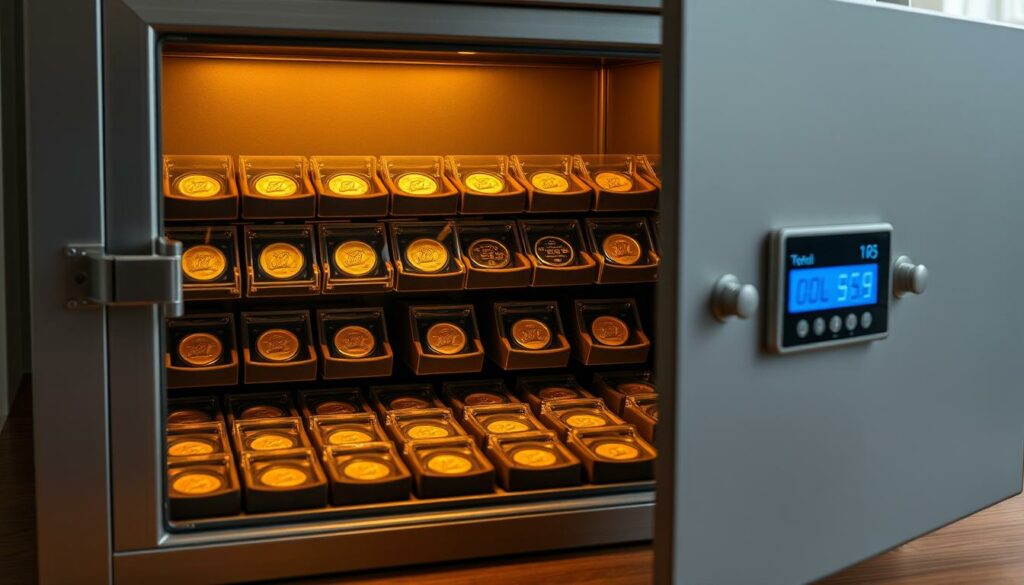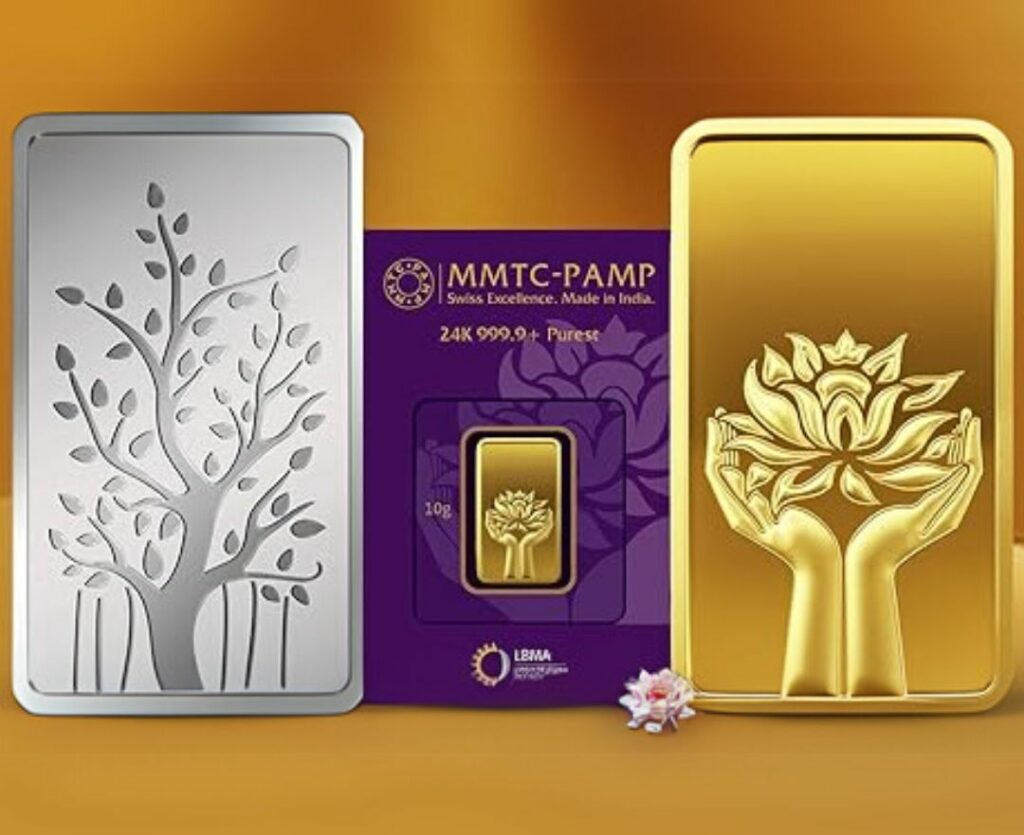Exclusive Deals & Trending Items


Tribhovandas Bhimji Zaveri & Sons Ganesh Color Silver Coin of 10 Grams in 999 Purity Fineness
Shop NowGold has been a symbol of wealth for thousands of years. But not all gold coins are genuine. It’s important to check the purity of gold coins before buying to protect your investment. Whether you’re collecting or investing, knowing the gold coin purity is key.
Purity levels, like 24K or 22K, affect the coin’s value and authenticity. With counterfeit risks, it’s crucial to know how to test gold coin purity.
Purity standards vary worldwide. In India, hallmarking is required for jewelry but not for coins. Pure gold, or 24K, has 99.9% purity. But, hallmarking often uses 995 fineness for 24K coins.
Testing methods like the magnet test or density check can verify authenticity. For example, pure gold isn’t magnetic, and 24K gold’s density is 19.32 g/ml. These tests help ensure you’re not buying counterfeit coins.
Key Takeaways
- Purity levels determine a gold coin’s value—24K (99.9%) is purest, while 22K is 91.7% pure.
- Gold coins lack mandatory hallmarks, requiring tests like magnet check or density analysis.
- Higher purity (999 fineness) costs up to 0.5% more than 995 fineness, as seen in the Rs 1,00,402 example.
- Professional methods like XRF or acid tests provide precise results, while home tests like the float test are simpler alternatives.
- India’s BIS hallmarking applies to jewelry, but coins need independent verification to avoid scams.
Understanding the Purity of Gold Coins
When you buy gold coins, it’s important to know the gold purity levels. This ensures you get the value you expect. Purity tells you how much pure gold is in the coin, measured in karats or fineness. This section will help you understand purity of gold coins better.
What Does Purity Mean in Gold Coins?
Purity shows how much pure gold is mixed with other metals. A 24-karat coin is almost pure, with 999 fineness (99.9% pure). But most coins use alloys for strength. Lower karats, like 22K (91.6% gold) or 18K (75%), mix metals like copper or silver. Here’s a quick guide:
- 24K = 999 fineness (pure gold)
- 22K = 916 fineness (91.6% gold)
- 18K = 750 fineness (75% gold)
- 14K = 585 fineness (58.5% gold)
Common Gold Purity Standards Around the World
In India, jewelry often uses 22K gold, balancing purity and strength. But, international standards vary. U.S. coins might be 22K or 18K, while European pieces can be as low as 14K. Always look for hallmarks to find these gold purity levels markers.
How Purity Affects Gold Coin Value
Higher purity means higher costs. A 24K coin is more expensive but can scratch easily. Lower karats, like 18K or 22K, are more durable for daily use. Think about both purity and practicality when choosing your investment.
Why Verifying Gold Coin Authenticity Matters
In India, authentic gold coins are valued for their cultural and financial worth, especially during Diwali and weddings. If not verified, buyers might end up with fake coins that seem real but are not pure gold coin purity. These fakes can drop in value by 40%, leaving you with nothing but worthless metal.
“Hallmarking is mandatory to protect consumers from substandard gold,” states the Bureau of Indian Standards (BIS).
- Financial risk: Fake coins may contain alloys or base metals, devaluing your investment.
- Cultural trust: Authentic gold coins gifted during festivals like Akshaya Tritiya lose meaning if counterfeit.
- Legal safeguards: BIS hallmarks (since June 2021) ensure 995 or 999 fineness, but unverified coins bypass these standards.
| Purity | Fineness | Use Case |
|---|---|---|
| 24KT | 999.9 | Investment-grade coins (e.g., Malabar’s 24KT coins) |
| 22KT | 916 | Wedding jewelry and festive gifting |
| 995 Fineness | 995 | Standard for RBI-approved coins |
During Diwali, many families buy gold coin purity-certified pieces like the Muthoot Group’s 0.5g coins. Without verification, you might pay for 24KT but receive 18KT metal. Always check hallmarks and buy from licensed sellers to safeguard your wealth and traditions.
Gold Purity Levels Explained: From 9K to 24K
Choosing the right gold purity depends on your needs. Let’s break down gold purity levels and what they mean for buyers like you.
24K Gold (99.9% Pure)
At 24K, gold is at its purest—99.9% gold. These high purity gold coins are great for investments. But, they are softer and less durable for jewelry. Look for a fineness mark of 999 or “24K” stamped on coins.
22K Gold (91.6% Pure)
22K gold is popular in Indian markets, with 91.6% gold. The rest is metals like copper for strength. This mix makes it a favorite for jewelry and cultural pieces.
18K Gold (75% Pure)
18K gold blends purity and durability with 75% gold. It’s common in everyday jewelry. It retains value and resists scratches better than higher karats. Check for “750” fineness stamps.
Lower Karat Options and Their Value
Lower karats like 9K (37.5% gold) offer affordability but lower resale value. While 14K or 10K gold may last longer, their lower gold purity levels mean they hold less investment potential compared to high purity gold coins.
- 24K = 99.9% gold (investment )
- 22K = 91.6% gold (jewelry staple in India)
- 18K = 75% gold (versatile for daily wear)
- 9K = 37.5% gold (budget-friendly but lower resale value)
Always check hallmarks and ask sellers about fineness. High purity gold coins like 24K might cost more, but they shine brighter in long-term value.
Hallmarks and Certifications: Your First Line of Defense
When you buy authentic gold coins, always look for official hallmarks. These marks show gold coin purity and legal approval. In India, the BIS system makes sure every real gold item has the right symbols.
- BIS Logo: This stamp proves it meets Indian standards.
- Purity in Karat: You’ll see 22K, 18K, or 14K with a matching fineness, like 916 for 22K.
- HUID Number: Since April 2023, every item has a unique 6-digit code. Scan it with the BIS Care App to check if it’s real.
| Karat | Fineness | Gold Content |
|---|---|---|
| 24K | 999 | 99.9% gold |
| 22K | 916 | 91.6% gold |
| 18K | 750 | 75% gold |
| 14K | 585 | 58.5% gold |
Since July 2021, all authentic gold coins must have the BIS logo, fineness, and HUID. Don’t buy coins without these marks or unclear engravings. Use the BIS Care App to scan HUID codes and check if they match BIS records. Remember, hallmarking is a must for all gold sold in India since 2021.
- Look for four key things: BIS mark, karat, fineness, and HUID
- Don’t buy coins without a 6-digit HUID (since April 2023)
- Check HUID via BIS Care App before buying
Be careful—fake hallmarks might be blurry or have wrong numbers. Keep your investment safe by choosing certified gold coin purity with these official signs.
Physical Inspection Techniques for High Purity Gold Coins
Checking authentic gold coins begins with simple steps you can do at home. Coins with 22K or 24K purity have clear signs. They should have a consistent golden color. Stay away from coins with green or dull spots, as they might be mixed with other metals.
Pure gold also feels heavier than metals like brass or copper.
Here’s how to test using your senses:
- Color Check: Real gold coins have a warm, even yellow color. Coins that look silver or white might not be pure.
- Weight Test: Compare the coin’s weight to a known standard. Pure gold is denser than fake coins.
- Sink Test: Drop the coin in water. Pure gold sinks fast; fake coins might float.
- Sound Test: Tap the edge gently. High purity gold coins ring out clearly; lower purity coins sound dull.
| Technique | How to Perform | What to Look For |
|---|---|---|
| Visual Inspection | Check for hallmarks and surface imperfections | BIS-certified logos and smooth, unblemished surfaces |
| Magnet Test | Hold a magnet near the coin | No attraction confirms non-magnetic properties of pure gold |
| Edge Observation | Scrutinize the coin’s edges under light | Sharp, uniform engravings (no blurred lines) |
These methods are just the start. For sureness, add lab tests to the mix. Always check for hallmarks from trusted brands like BIS-certified sellers in India. If unsure, use electronic testers or XRF analyzers for accurate results.
Using Simple Tools to Test Gold Coin Purity at Home
Checking gold coin purity doesn’t need fancy lab tools. Try these simple ways to spot fakes before you buy or sell:
The Magnet Test Explained
Magnets can show hidden metals. Here’s how to do it:
- Hold a magnet near the coin. Pure gold purity of gold coins won’t stick.
- If it moves toward the magnet, the coin likely contains iron or other metals.
- Remember: Some fakes are non-magnetic too—this test alone isn’t enough.
Water Displacement Method
Gold’s high density (19.3g/cm³) helps spot fakes. Steps:
- Weigh the coin on a kitchen scale (mass in grams).
- Submerge it in water to measure volume displacement (in cm³).
- Divide mass by volume. If the result is less than 19.3, purity is low.
The Ping Test for Authentic Gold Coins
Tap the coin gently with a metal tool. Pure gold gives a muted “ping” sound. Fake coins might sound tinny or dull. Compare with a known pure sample if possible.
Always pair these tests with professional certification. For best results, combine methods and check hallmarks first. Stay cautious—no home test replaces lab analysis.
Advanced Testing Methods Used by Professionals
Experts use special tools to check the purity of gold coins. These methods are accurate, protecting investments and keeping value high. Here’s how experts find hidden details in gold:
XRF Technology for Gold Analysis
X-ray fluorescence (XRF) scans coins with harmless X-rays. It shows exact gold purity levels without harming the surface. This method is precise, often used by certified labs. For example, the TTD-1200K is 100% accurate, making it reliable for valuable coins.
Acid Testing Procedures
Acid tests scratch the coin and apply chemicals. The color change shows gold purity levels. It’s quick but might leave small marks. Though not as advanced as XRF, it’s used in shops for its speed and cost.
Ultrasonic Testing for Internal Flaws
Ultrasonic waves go through coins to find hidden impurities or defects. This method checks the purity of gold coins without seeing them, important for big investments.
| Method | Description | Pros | Cons |
|---|---|---|---|
| XRF Testing | Uses X-rays to analyze composition without damage. | Non-destructive, highly accurate. | Requires specialized equipment. |
| Acid Testing | Chemical reactions reveal purity through color changes. | Affordable, portable. | Leaves surface marks. |
| Ultrasonic Testing | Sounds waves detect internal flaws. | Reveals hidden defects. | Needs expert interpretation. |
Testers like the TTD-153K and TTD-214K are precise, with some being 100% accurate. Always ask for certification reports to confirm results.
Common Counterfeit Techniques and How to Spot Them
Counterfeiters are always coming up with new tricks. But, knowing their tactics can keep you safe. Authentic gold coins must meet strict purity standards. Here are some red flags to watch out for:
- Tungsten Cores: Fake coins often hide tungsten cores. Though heavy like gold, XRF scans expose non-gold elements.
- Plated Fakes: Brass or copper cores with gold plating. Scratch tests reveal the core, while acid tests dissolve coatings.
- Low-Density Metals: Cheaper metals like silver or copper alloyed with gold reduce purity. Density tests compare to gold’s 19.32 g/cm³ standard.
Look for inconsistencies: coins that feel too light, uneven edges, or unnatural scratches. A magnet test can flag non-gold alloys since pure gold isn’t magnetic.
In 2019, $18,000 “gold” bars were 80% tungsten. Over 40% of eBay listings for gold products are reported as suspect. Stick to sellers certified by bodies like LBMA to ensure gold coin purity.
Always verify hallmarks with trusted assayers. Professional XRF scans or third-party reports are musts when buying large investments. Protect your savings—knowledge shields you from costly mistakes.
Top Rated Gold Coins Known for Their Purity
When you buy gold coins, picking top rated gold coins with the best gold coin purity is key. This ensures your investment stays valuable. Let’s look at trusted options from India and around the world.


Indian Gold Coins with Established Reputation
Indian buyers often choose coins from the India Government Mint. The Indian Gold Coin Program offers 24K gold with 99.9% purity. It comes with reliable certifications. Private mints like MMTC-PAMP also make coins with 99.99% purity, meeting global standards.
International Options for Pure Gold
For global investors, these coins are the best:
- Canadian Maple Leaf: 99.99% purity, available in 1 oz and smaller sizes
- Australian Kangaroo: 99.99% purity, known for its design and liquidity
- American Buffalo: 99.99% purity, with collectible editions that fetch high prices
Comparing Purity and Availability
| Coin | Purity | Availability |
|---|---|---|
| Canadian Maple Leaf | 99.99% | Worldwide, including India via authorized dealers |
| South African Krugerrand | 91.67% | Popular but note its lower purity compared to 99.99% options |
| Austrian Philharmonic | 99.99% | Available in 1 oz and fractional sizes |
Limited editions, like the Canadian Maple Leaf’s special releases, sometimes fetch higher prices. They match standard purity but have a premium. Always check purity, price, and certification before you buy.
Best Practices When Purchasing Gold Coins in India
When buying gold coins in India, always demand a detailed bill listing karat, weight, and charges. Look for high purity gold coins with BIS certification to ensure best gold coin purity. Here’s how to protect your investment:
“The Bureau of Indian Standards (BIS) certifies over 300 hallmarking centers nationwide. Always verify the BIS logo and HUID number on coins.”
- Check for BIS hallmarks: Look for the BIS logo, purity mark (e.g., 916 for 22K), and the seller’s identification code.
- Compare making charges: Fees vary between 8%–16%. Ask for transparent pricing.
- Time your purchase: Avoid festival peaks when prices surge. Buy during low-demand periods for better rates.
- Choose licensed sellers: Opt for banks or BIS-licensed jewellers. India has 13,000 licensed sellers—research their reputation.
Store receipts safely. Remember, selling before three years triggers short-term capital gains tax. For long-term holds, the 20% tax with indexation offers better savings. Always keep coins in dry, cool places to avoid damage. Avoid cleaning unless necessary—improper handling lowers resale value.
Invest in machine-made coins for lower costs. Check for GST (3%) and international pricing trends to avoid overpaying. With these steps, you secure both purity and value in your gold coin investments.
The Relationship Between Purity and Pure Gold Coin Values
When you buy gold coins, gold purity levels really matter. Higher purity means more value, but there are trade-offs. Let’s explore how this impacts your investment.
Price Premium for Higher Purity
- 24K gold (999.9 fineness) costs 0.4–0.5% more than 22K coins of the same weight.
- Even small differences matter: 999 fineness coins cost 0.4% more than 995 purity versions.
- Higher purity = higher premiums, but also better resale potential in premium markets.
Resale Value Considerations
Resale prices depend on gold purity levels and market trends. Dealers often pay less for lower purity coins during buybacks. For example:
- 916 fineness (22K) coins may lose 3-5% of their value when reselling due to mixed metals.
- Pure 999.9 coins retain value better during festive seasons like Dhanteras, when demand peaks.
Long-term Investment Perspective
Over time, 999.9 purity coins often outperform lower grades during economic instability. Why?
- High-purity coins attract global markets, ensuring liquidity even during crises.
- Historically, 24K gold holds its value better than 18K or 14K during inflation spikes.
- Spread investments across gold purity levels to balance cost and long-term growth.
Remember: the pure gold coin values rise with purity, but diversify to match your financial goals. Always check certifications to confirm stated purity before buying!
Storing and Maintaining Your Verified Gold Coins


Keeping your high purity gold coins safe and valuable is key. First, pick a secure spot. Home safes with fireproof and burglar-resistant features are good. Bank lockers also offer insured monitoring, which 40% of investors use.
For extra security, look into bank lockers. They have insurance up to 2% of the stored value. This is perfect for top rated gold coins.
- Use dry, temperature-controlled spaces to prevent tarnish in humid climates.
- Avoid plastic containers—chemical reactions can damage gold.
- Store coins in individual cloth pouches or velvet-lined boxes to avoid scratches.
When handling coins, wear cotton gloves to prevent oils from tarnishing. Keep a detailed inventory with photos and weights. This boosts successful insurance claims by 50%.
Do regular audits every year to keep your collection in top shape.
| Storage Option | Pros | Cons |
|---|---|---|
| Home Safe | Convenient access | Risk of burglary |
| Bank Locker | Insured and monitored | Access fees |
| Specialized Facilities | 24/7 security | Higher costs |
Use tamper-proof packaging to protect your investment. Original wrapping can increase resale value by 15%. Always hide safes in hidden spots and consider using cameras (30% of investors do).
If you’re worried about natural disasters, choose climate-controlled facilities. Lastly, document everything for tax and insurance purposes.
Legal Protections for Gold Coin Buyers in India
When you buy purity of gold coins, knowing your rights is crucial. Laws like the Gold (Control) Act 1965 and Consumer Protection Act 2019 help. They make sure sellers give correct info about authentic gold coins and their purity. Here’s what you need to know about your rights and what to do if problems come up.
Consumer Rights When Purchasing Precious Metals
- Right to clear details: Sellers must disclose purity, weight, and hallmark certification.
- Right to refunds: Fake or mislabeled products qualify for returns under the Consumer Protection Act.
- Legal recourse: File complaints with consumer courts if rights are violated.
Recourse Options for Counterfeit Sales
If you spot counterfeit coins, here’s what to do:
- File a complaint with a consumer court within 2 years of purchase.
- Contact local police for fraud cases involving fake authentic gold coins.
- Report violations to BIS or state consumer forums for mediation.
Documentation You Should Always Keep
| Document | Description | Importance |
|---|---|---|
| Purchase receipt | Includes seller details and transaction date. | Proves ownership and purchase history. |
| BIS hallmark certificate | Lab-verified purity stamp. | Legal proof of gold purity standards. |
| Warranty card | Details after-sales service terms. | Supports claims for defects or fraud. |
Keep these documents safe for 5+ years after buying. They help in disputes and when reselling. Also, licensed sellers must show their dealer license in stores. Knowing your legal rights helps protect your investment!
Conclusion
When you buy gold coins, making sure they are best gold coin purity is key. This protects your investment and keeps your savings safe. Start by looking for BIS hallmarks or international certifications to check if they are real.
Simple tests like the magnet test or density check can spot basic fakes. But for the most accurate results, use professional tools like XRF machines.
Coins with high purity, like the Canadian Maple Leaf (99.99%), have higher resale values. Coins with alloys in them have less gold. Always buy from trusted dealers to avoid fake coins made of tungsten.
Each type of coin, old or new, has its own purity standards. Knowing these helps you pay the right price.
Gold is a stable investment, with pure gold coin values going up over time. In India, BIS hallmarking and proper documents protect against scams. Whether you choose 22K coins or 24K bars, focus on clear information and avoid myths.
With the right knowledge and tools, you can confidently invest in India’s gold market. Every purchase can become a secure, long-term asset.



















